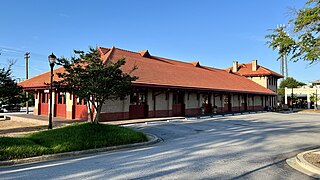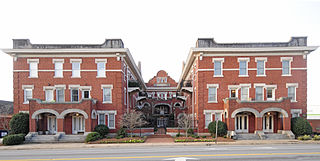
Greer is a city in Greenville and Spartanburg counties in the U.S. state of South Carolina. The population was 35,308 as of the 2020 census. Greer is a included in the Greenville, SC Metropolitan Statistical Area, which is part of the Greenville-Spartanburg-Anderson, SC Combined Statistical Area in Upstate South Carolina.
Tigerville is an unincorporated community and census-designated place in Greenville County, South Carolina, United States. As of the 2010 United States Census the population was 1,312. It lies 12 miles (19 km) north of Taylors, 10 miles (16 km) northeast of Travelers Rest, and 14 miles (23 km) northwest of Greer. North Greenville University, a private institution of higher education affiliated with the Southern Baptist Convention, and whose baseball team won the national NCAA Division II baseball tournament in 2022, is located in Tigerville. The community is part of the Greenville–Mauldin–Easley Metropolitan Statistical Area.

Ashtabula is a plantation house at 2725 Old Greenville Highway near Pendleton in Anderson County, South Carolina, USA. It has been also known as the Gibbes-Broyles-Latta-Pelzer House or some combination of one or more of these names. It was named in the National Register of Historic Places as a historic district on March 23, 1972. It is considered a significant example of a Lowcountry style plantation house built for a Charleston family in the Upstate in the early 19th century. It also is part of the Pendleton Historic District.

Greenville Presbyterian Church is a historic Presbyterian church located near Donalds, Greenwood County, South Carolina. It was built in 1852 and is a meeting house form, Greek Revival style brick church. Also on the property are a small brick Session House, a large historic cemetery containing about 1,200 identifiable graves, and a natural spring. The earliest graves in the church cemetery date from 1777 and numerous markers indicate service in the American Revolution and American Civil War.

The Earle R. Taylor House and Peach Packing Shed, in Greenville County, South Carolina, near Greer, South Carolina. It was listed on the National Register of Historic Places on June 27, 2012.

The Arthur Barnwell House, which is also known as the Barnwell-DeCamps House, is a Queen Anne house in Greer, South Carolina that was built in the period 1880–1900. It was named to the National Register of Historic Places on 1982. As of 2013, the house was in the process of being moved and rebuilt at a new location.

The Robert G. Turner House is located in Greer, South Carolina. The Colonial Revival style brick veneered house was designed by the prominent Greenville, South Carolina-based architect William Riddle Ward for Robert Gibbs Turner and Turner's wife, Mary. Ward also designed the one-story brick veneered garage to match the house.

The R. Perry Turner House is located in Greer, South Carolina. The Classical Revival style house was built in 1937 for prominent local businessman Richard Perry Turner. The house was designed by Greenville-based architect William Riddle Ward, commissioned after Turner saw the house designed by Ward for his younger brother, Robert Gibbs Turner.

The Louie James House is a property listed on the National Register of Historic Places located in Greer, South Carolina. The two-story Colonial Revival frame house on a brick basement foundation was built in 1923 for William Louis James. It was designed by the architect Henry R. Trott, from Greenville, South Carolina based architectural firm Jones and Trott.

The Greer Depot is a former railroad depot listed on the National Register of Historic Places and located in Greer, South Carolina. The combination passenger station and freight warehouse was designed by the Charlotte, North Carolina-based architect, Charles Christian Hook, and constructed in 1913 for the Piedmont and Northern Railway. The depot was designed as a combination passenger station and freight warehouse for the Piedmont & Northern Railway and later used by Seaboard Coast Line Railroad, before facing potential demolition in 1983. It is the last surviving of the original 5 two-story depots built for the railway.

Greer Downtown Historic District is a national historic district located at Greer, Greenville County, South Carolina. The district encompasses 40 contributing buildings constructed from ca. 1900 to ca. 1940, with the majority constructed between 1910 and 1930 in the central business district of Greer. They are largely two-story brick commercial structures. Notable buildings include the First National Bank of Greer, Planters Savings Bank, R. L. Merchant Building, Bailey Building, Bailes-Collins Department Store, and Davenport Building.

Earle Town House is a historic house in Greenville, South Carolina. It was listed in the National Register of Historic Places on August 5, 1969, and is included in the Col. Elias Earle Historic District.

The Lanneau-Norwood House is a historic, late 19th-century house on Belmont Avenue in Greenville, South Carolina. The house is an outstanding example of Second Empire architecture in the American South and is one of the last surviving Victorian-era homes in Greenville. The property was added to the National Register of Historic Places in 1982.

Davenport Apartments is a historic apartment building located at Greenville, South Carolina. It was built in 1915–1916, and is a three-story, "U"-shaped, brick building. It consists of a large rectangular section in the rear with two smaller wings that extend from the rear block to the street. The front façade features two one-story porches with stone elliptical arches and brick pillars.

Working Benevolent Temple and Professional Building is a historic office building located at Greenville, South Carolina. It was built in 1922, and is a three-story, steel frame brick building. The building housed offices for African-American doctors, lawyers, dentists, a newspaper, and insurance firms and housed the first black mortuary in Greenville. The temple was also the center for Greenville's civil rights activities during the 1960s.

Greenville County Courthouse, also known as Greenville Family Courts Building, is a historic courthouse located at Greenville, South Carolina. It was built in 1918, and is a Beaux-Arts style brick and concrete building with terra cotta trim. The building consists of a three-story front section, with an eight-story tower behind. The building served as the courthouse for Greenville County until 1950 when the court was moved to a new building. The Family Court of Greenville County was located then in the building and remained there until 1991.
Brushy Creek, also known as Vardry McBee House and Alexander McBee House, is a historic home located at Greenville, South Carolina. It was built about 1836 as a 1+1⁄2-story, frame farmhouse. In 1924, the house was expanded with the addition of a one-story frame room that incorporated the formerly separate kitchen into the house itself. Further renovations were made in 1938–1939 and 1951. Also on the property are a log barn, a brick shed, a well house, and the ruins of a grist mill. It was the home of Vardry McBee (1775–1864), prominent 19th-century businessman, entrepreneur, and delegate to the Secession Convention of Greenville District, known as the “Father of Greenville,” and his son Alexander McBee (1822–1897), prominent 19th-century businessman, banker, and state representative of Greenville District.

West End Commercial Historic District is a national historic district located at Greenville, South Carolina. It encompasses 15 contributing buildings in Greenville's second "downtown." The commercial buildings primarily date from about 1880 to 1920, and include examples of Victorian commercial architecture. Notable buildings include the American Bank, Alliance and Mills & McBayer Cotton Warehouses, Indian River Fruit Store, Pete's Place, Bacot's West End Drug Store/Stringer's Drug, Furman Lunch, and Greer Thompson Building.

R. T. Greer and Company Root and Herb Warehouse is a historic warehouse located near Todd, Ashe County, North Carolina. It was built about 1918, and is a two-story, rectangular, timber framed commercial building. It is sheathed in corrugated metal sheet siding and rests on a brick pier foundation.

The Wilkins House is a historic house in Greenville, South Carolina, built in 1878 by Jacob W. Cagle (1832–1910) for merchant and capitalist William T. Wilkins (1825–1895). It was listed on the National Register of Historic Places on July 19, 2016.





















